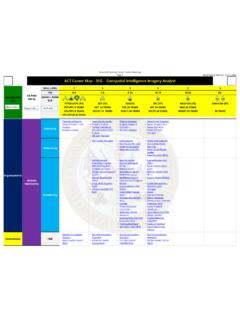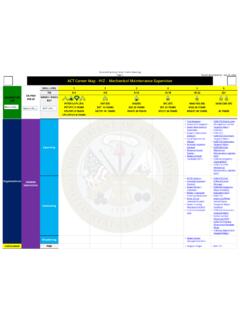Transcription of Cyber Aptitude Assessment – Finding the Next Generation of ...
1 Cyber Aptitude Assessment Finding the Next Generation of enlisted Cyber Soldiers MSG Jeffrey D. Morris, USA and CPT Frederick R. Waage, USA. DEPARTMENT OF THE ARMY. UNITED STATE MILITARY ACADEMY. ARMY Cyber INSTITUTE. West Point, New York The views expressed in this work are those of the authors and do not reflect the official policy or position of the United States Army, Department of Defense, or the United States Government. This material is declared a work of the Government and is not subject to copyright protection in the United States. 2. Contents Executive Synopsis .. 4. 4. Discussion of Testing 5. CATA ( Cyber Aptitude and Talent Assessment ) .. 5. ASVAB Cyber Test (CT) (Formerly the Information Communications Technology Literacy test (ICTL)) 7. Cyber Talent Enhanced SANS .. 9. The Cyber Talent Targeting Methodology (CTI) .. 10. FIND PIECE: Identify Key Technical Terrain Where Cyber Talent Converges.
2 11. FIX PIECE: Identify Cyber Talent and Recruit .. 12. FINISH PIECE: Cyber Assessment & Selection Program (CASP).. 12. Instrument Results .. 14. Discussion and Recommendations .. 15. References .. 17. 3. Executive Synopsis The Department of Defense (DoD), and the US Army, are rapidly expanding the positions and personnel to operate in the cyberspace domain, one of the five independent warfighting domains [1]. Recognizing the importance of integrating Cyber operations throughout the Army led to the recent creation of a new Cyber branch, the first new branch in decades. Filling these new positions with the best qualified personnel is not an easy task. The DoD Cyberspace Workforce Strategy of 2013 lays outs requirements to assess Aptitude and qualifications, noting not all successful cyberspace personnel will have a Science, Technology, Engineering and Math (STEM) background.
3 Rather, a broad range of experiences can lead to a qualified cyberspace employee. The Strategy directs developing Aptitude Assessment methods to identify individuals' thinking and problem- solving abilities as tools for recruitment. Further, it directs DoD to evaluate the availability or development of Assessment tools to identify military candidates for cyberspace positions. [2]. This paper begins with a discussion of the issues surrounding Aptitude Assessment and continues by identifying several existing test instruments. It then identifies testing results and finishes with several recommendations for talent identification. Introduction As noted in the 2003 DoD Cyberspace Workforce Strategy, not all cyberspace personnel will have a STEM background, but instead will come from a broad variety of backgrounds [2]. The problem is trying to find personnel having the knowledge and Aptitude for cyberspace operations.
4 There are many instruments available to measure knowledge, but there few that measure Aptitude . The traditional military approach of over-selecting numbers of personnel for training to fill requirements may not be the best approach for cyberspace forces. Selecting the right personnel and investing in them will be as important as investing in the correct hardware and software [3]. While making progress in selecting and filling Cyber positions, the DOD. is steadily losing ground. General Keith Alexander (former head of the USCYBERCOM). noted in 2013 [USCYBERCOM's] progress, however, can only continue if we are able to fulfill our urgent requirement for sufficient trained, certified, and ready forces to defend national interests in cyberspace [2]. The challenge is identifying the right people for the job. There is some agreement that developed cognitive problem-solving is a desired trait for Cyber personnel, but there is 4.
5 Much argument on how to measure if a candidate has it. The traditional testing method for military accessions does not properly test for desired Cyber traits. These needs suggest the military requires different methods and authorities for filling the Cyber force [4, 5]. The 2003 DoD Cyberspace Workforce Strategy suggests employing a multi-dimensional, innovative approach to recruiting, by assessing Aptitude and helping to create a national cyberspace talent pipeline [2]. This approach needs to evaluate cognitive talents tied to the various cybersecurity jobs identified by the National Institute for Cybersecurity Education (NICE), which are organized by mission function [6]. Rather than measuring current knowledge, the Assessment needs to look for factors affecting an applicant's Aptitude and potential success in Cyber operations [7]. Potential cyberspace personnel fall into two categories: new accessions into the military and current military personnel requesting assignment to cyberspace operations.
6 New accessions come from a background where computers and computing devices are commonplace and many are digital or net natives that have grown up surrounded by the Internet and digital communication devices. Many have become accustomed to teaching the older Generation how to use current technology. This is a reverse of the typical paradigm considering young individuals as amateurs or students [5]. Current military personnel wanting to move into Cyber careers are another challenge for identifying potential Cyber personnel. Personal interest in Cyber motivates many of these personnel, rather than military training. Finding those with the Aptitude for Cyber , rather than technical qualifications, needs a different Assessment , but would expand the pool of available talent [2]. Discussion of Testing Instruments This section describes several existing Aptitude tests identified during a literature search.
7 Each subsection describes what the test measures, the potential test population, background information about the test, and who created the test. Supporting statistics and information further explains the details of the test. CATA ( Cyber Aptitude and Talent Assessment ). The CATA is a test created by the University of Maryland Center for Advanced Study of Language (CASL) based on their experience in creating a second- Generation version of the Defense Language Aptitude Battery (DLAB). The DoD Cyberspace Workforce Strategy produced in 2013 directs the DoD to evaluate assessments to augment or replace existing tools by using the DLAB as one of the models for an Aptitude Assessment . 5. The document does not specify using a DLAB-based Assessment , only perform the evaluation using the DLAB as a basis. The CATA is designed to predict Cyber Aptitude beyond assessing general intelligence.
8 The CATA model uses classification of jobs requiring deliberate performance or action and proactive and reactive actions. Deliberate action is a combination of critical thinking ability and the ability to defer resolution. Their model of cybersecurity performance consists of two components: critical thinking and measurement of constructs that match particular cybersecurity jobs [8]. The CATA is designed to assess discrete cognitive skills identified as key to categories identified in a cybersecurity job model designed by CASL. See Figure 1 for a graphic showing the four dimensions of the CASL model. Figure 1. Schematic of the dimensions on which example Cyber careers differ. The quadrant names (in bold uppercase font; , ATTACKING) correspond to a major job task that has the characteristics described on its axes (for instance, defending requires real-time reaction, while development requires proactive deliberation).
9 Example job titles, which appear within quadrants, are taken from the NICE. framework [8]. CASL suggests measuring different aspects of critical thinking, based on their review of predicted performance indicators in computer science and STEM occupations. The CATA. measures: visuospatial working memory, rule induction, complex problem-solving, spatial visualization, and attentional capacity. The CATA design does not assess written or verbal skills because they are assessed using the Armed Services Aptitude Battery (ASVAB) or an interview process [8]. Table 1 lists the proposed content of the CATA. 6. Table 1. Proposed content of the CASL's CATA, section, construct, and proposed test to measure that construct. See [6] for a detailed description of each section and test. Section Construct Test Critical Thinking Visuospatial Working Memory Shapebuilder Rule Induction Letter Sets Complex Problem-Solving Dynamic Systems Control Spatial Visualization Paper Folding Attentional Capacity Shape Comparison Deliberate Action Need For Closure Need For Cognitive Closure Tolerance For Risk Balloon Analogue Risk Task Real-Time Action Psychomotor Speed Recent Probes (1 item).
10 Pattern Recognition and Scanning Decoding Speed Resistance To Interference Recent Probes (4 & 9 Items). Proactive Thinking Modeling Program Execution Spatial Integration Creativity Remote Associates Test Reactive Thinking Anomaly Detection Anomalous Behavior Test Vigilance Pattern Vigilance ASVAB Cyber Test (CT) (Formerly the Information Communications Technology Literacy test (ICTL)). The Information/Communication Technology Literacy (ICTL) (now known as the Cyber Test (CT)) began as a request by the Office of the Assistant Secretary of Defense to the Defense Manpower Data Center to review of the ASVAB in 2005. There were concerns the ASVAB content was outdated due to rapid changes in computer technology throughout the military. Accelerating these changes were continuing combat operations and an increasingly computer-centric form of warfare. Also, the services needed to identify characteristics needed for military personnel to use these new systems [9].


